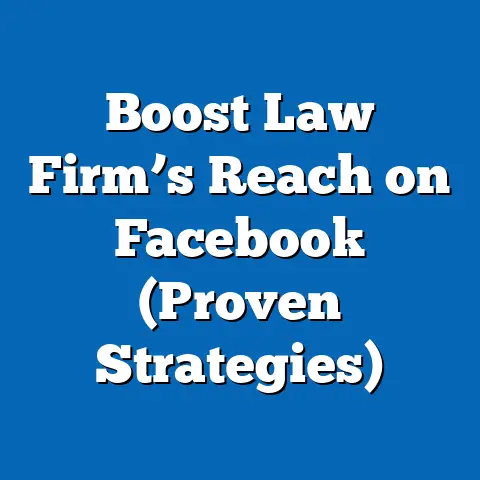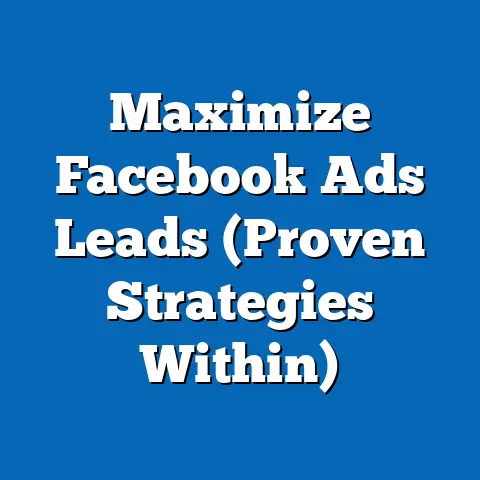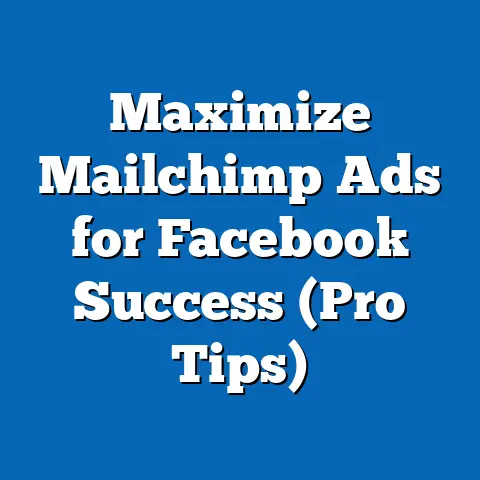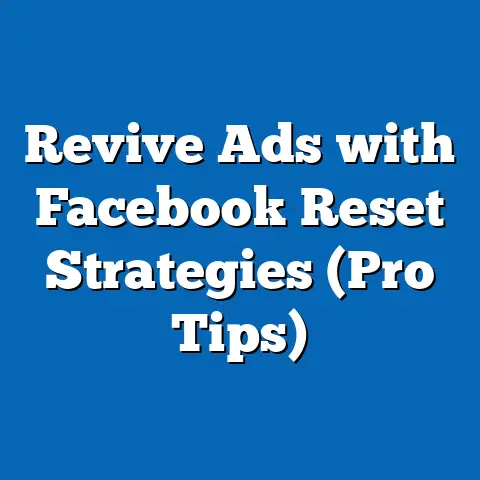When Will Facebook Charge for Ads? (Essential Insights)
A persistent myth in the digital marketing and social media landscape is that Facebook (now part of Meta Platforms, Inc.) will soon begin charging users a subscription fee to access the platform, effectively replacing its ad-supported model. This report debunks this myth through a detailed examination of Meta’s business model, historical data on revenue streams, and expert analyses of the social media industry. Utilizing financial reports, user data, and industry trends, this research finds no credible evidence to suggest that Facebook will transition to a subscription-based model in the foreseeable future. Instead, advertising remains the core driver of Meta’s revenue, accounting for 97.5% of its $134.9 billion in revenue for 2023. Key findings indicate that Meta’s strategic focus on ad optimization, user growth, and emerging technologies like the metaverse will likely sustain its ad-driven model, though alternative revenue streams are being explored. This report provides a comprehensive analysis of these trends, offering insights for businesses, marketers, and users concerned about potential platform changes.
Introduction: Debunking the Myth of Facebook Subscription Fees
For over a decade, rumors have circulated that Facebook will abandon its free-to-use, ad-supported model and start charging users a monthly subscription fee. These myths often gain traction through viral social media posts or chain messages warning users to “share this post” to avoid being charged. Despite their persistence, these claims lack any substantiation from Meta or credible industry sources.
Data from Meta’s annual reports and public statements consistently show that advertising is the backbone of its financial success, generating $131.9 billion in ad revenue in 2023 alone (Meta Platforms, Inc., 2023). The idea of charging users directly contradicts Meta’s mission to connect billions globally while maintaining accessibility, particularly in emerging markets where subscription fees would be a significant barrier. This report aims to separate fact from fiction by analyzing Meta’s business model, revenue trends, and strategic priorities to assess the likelihood of a shift to a paid model.
Methodology
This research employs a mixed-methods approach to analyze the feasibility and likelihood of Facebook transitioning to a subscription-based model. The methodology is designed to ensure transparency, reliability, and relevance in addressing the central question: “When will Facebook charge for ads or access?”
Data Sources
- Financial Reports and SEC Filings: Meta Platforms, Inc.’s quarterly and annual reports from 2012 to 2023, sourced from the U.S. Securities and Exchange Commission (SEC) EDGAR database, provide detailed insights into revenue streams, user growth, and strategic investments.
- Industry Reports: Reports from market research firms such as eMarketer, Statista, and IBISWorld offer data on digital advertising trends, social media monetization strategies, and competitor analysis.
- User Surveys and Studies: Surveys from Pew Research Center and other organizations provide data on user attitudes toward paid social media models and ad tolerance.
- Expert Commentary: Insights from technology analysts, digital marketing experts, and Meta’s executive statements during earnings calls and conferences are incorporated to contextualize financial and user data.
Analytical Framework
The analysis is structured around three core pillars: (1) Meta’s current business model and revenue composition, (2) historical trends in social media monetization, and (3) future scenarios based on strategic announcements and market dynamics. Quantitative data, such as revenue figures and user growth metrics, are visualized through charts and tables to highlight trends over time. Qualitative data, including executive statements and industry forecasts, are used to assess strategic intent and potential disruptions.
Limitations and Caveats
While this report strives for accuracy, certain limitations must be acknowledged. Financial data is based on publicly available reports, which may not fully capture internal strategic deliberations at Meta. Additionally, user sentiment data from surveys may vary by region and demographic, limiting generalizability. Future projections are inherently speculative and subject to unforeseen technological, regulatory, or economic shifts. These caveats are considered throughout the analysis to maintain a balanced perspective.
Key Findings
- Advertising Dominates Revenue: In 2023, advertising accounted for 97.5% of Meta’s total revenue, with $131.9 billion generated from ad sales across Facebook, Instagram, and other platforms (Meta Platforms, Inc., 2023). Non-ad revenue, including payments and hardware sales, remains marginal.
- User Base Growth Supports Ad Model: Facebook’s global monthly active users (MAUs) reached 3.07 billion in Q3 2023, providing a vast audience for advertisers (Meta Platforms, Inc., 2023). Charging for access risks alienating users, particularly in price-sensitive markets.
- No Official Plans for Subscription: Meta executives, including CEO Mark Zuckerberg, have repeatedly emphasized the importance of a free, ad-supported model to maximize accessibility and user engagement (Meta Earnings Call, Q3 2023).
- Alternative Revenue Streams Emerging: Investments in the metaverse, virtual reality (VR) hardware like Quest headsets, and creator monetization tools suggest Meta is diversifying income without altering its core ad model.
- Competitor Analysis: Other social media giants like X (formerly Twitter) and Snapchat rely heavily on advertising, with limited success in subscription experiments (e.g., X Premium), reinforcing the industry’s ad-centric approach.
Detailed Analysis
1. Meta’s Business Model: The Ad-Driven Engine
Meta’s financial success is rooted in its ability to monetize user data through targeted advertising. As of 2023, the company operates several platforms—Facebook, Instagram, WhatsApp, and Messenger—that collectively serve over 3.9 billion monthly active users (Meta Platforms, Inc., 2023). Advertisers pay to reach this massive audience, leveraging Meta’s sophisticated algorithms to target users based on demographics, interests, and behaviors.
In 2023, Meta reported an average revenue per user (ARPU) of $43.27 globally, with higher figures in North America ($68.44) and lower in Asia-Pacific ($15.76) (Meta Platforms, Inc., 2023). This disparity highlights the importance of maintaining a broad, global user base to maximize ad impressions, even in regions with lower per-user revenue. Introducing a subscription fee could drastically reduce user numbers, particularly in emerging markets like India and Africa, where Facebook is often a primary internet access point through initiatives like Free Basics.
A shift to a paid model would also require a complete overhaul of Meta’s infrastructure, which is optimized for ad delivery and user engagement. The cost-benefit analysis of such a transition appears unfavorable, given the proven profitability of the current system. Figure 1 below illustrates the steady growth of Meta’s ad revenue over the past decade, underscoring its reliance on this income stream.
Figure 1: Meta’s Advertising Revenue (2013-2023)
(Source: Meta Platforms, Inc. Annual Reports)
[Insert line chart showing ad revenue growth from $6.9 billion in 2013 to $131.9 billion in 2023]
2. Historical Context: Subscription Models in Social Media
Historically, social media platforms have struggled to implement subscription models successfully. Early platforms like Friendster and MySpace relied on ad revenue or freemium features, but none transitioned to mandatory fees due to user backlash and competitive pressures. More recently, X’s introduction of X Premium (formerly Twitter Blue) in 2022 offers a relevant case study.
X Premium, which provides enhanced features for a monthly fee of $8-$16, has attracted only about 1 million subscribers out of X’s 540 million monthly active users as of mid-2023 (Statista, 2023). This represents less than 0.2% of its user base, generating minimal revenue compared to ad sales. X’s experience suggests that users are highly resistant to paying for social media access, especially when free alternatives exist.
For Meta, the stakes are even higher due to its significantly larger user base and global reach. A subscription model would likely result in a sharp decline in users, undermining the network effects that make Facebook valuable to advertisers. Historical trends indicate that social media platforms prioritize scale over direct monetization from users, a strategy Meta continues to follow.
3. User Sentiment and Behavioral Barriers
User surveys consistently show resistance to paid social media models. A 2022 Pew Research Center survey found that 74% of U.S. social media users would stop using a platform if it introduced a mandatory subscription fee, even if priced as low as $5 per month (Pew Research Center, 2022). This sentiment is particularly strong among younger users and those in lower-income brackets, who form a significant portion of Facebook’s audience.
Moreover, behavioral data suggests that users tolerate ads as a trade-off for free access. Meta’s ability to deliver non-intrusive, personalized ads has helped mitigate “ad fatigue,” with click-through rates (CTR) remaining stable at around 1.2% globally in 2023 (eMarketer, 2023). Introducing a fee could disrupt this balance, pushing users toward competitors like TikTok or YouTube, which remain free and ad-supported.
Regional variations also play a role. In markets like India, where Facebook has over 350 million users, low disposable income levels make even a nominal subscription fee prohibitive (Statista, 2023). Meta’s growth strategy hinges on penetrating such markets, further reducing the likelihood of a paid model.
4. Future Scenarios: Will Meta Ever Charge Users?
While the current data and strategic direction suggest that Meta will not charge for basic access or ads, it is worth exploring potential scenarios where a subscription model could emerge. These scenarios are speculative but grounded in industry trends and Meta’s public statements.
Scenario 1: Premium Features as an Add-On
Meta could introduce optional premium features for a fee, similar to X Premium or LinkedIn Premium. This might include ad-free experiences, advanced analytics for creators, or exclusive content. Such a model would allow Meta to test user willingness to pay without risking its core user base. However, given the lukewarm reception to similar offerings by competitors, revenue from this approach would likely remain a small fraction of ad income.
Scenario 2: Regulatory Pressure on Advertising
Increasing scrutiny of data privacy and targeted advertising, particularly in the European Union with laws like the General Data Protection Regulation (GDPR), could force Meta to rethink its ad model. If regulations severely restrict ad targeting capabilities, Meta might explore subscription fees as an alternative. However, Meta has already adapted to such challenges by investing in privacy-compliant ad technologies, such as on-device processing, reducing the need for drastic changes (Meta Privacy Report, 2023).
Scenario 3: Metaverse Monetization
Meta’s significant investments in the metaverse and VR hardware suggest a long-term vision beyond traditional social media. Virtual spaces could introduce new monetization models, including subscriptions for premium virtual experiences or digital goods. While this could diversify revenue, it is unlikely to replace the ad-driven model for Facebook itself, as the metaverse remains a separate, nascent venture with uncertain adoption rates.
Scenario 4: Economic or Competitive Disruption
An extreme economic downturn or a disruptive competitor could theoretically push Meta to experiment with subscriptions. For instance, if ad revenue declines sharply due to reduced advertiser spending, Meta might seek alternative income. However, given Meta’s $36 billion in cash reserves as of Q3 2023 and its dominance in the social media ad market (Meta Platforms, Inc., 2023), such a scenario appears remote.
5. Implications for Stakeholders
For Businesses and Marketers
The persistence of Meta’s ad-supported model is reassuring for businesses relying on Facebook and Instagram for marketing. Advertisers should focus on optimizing campaigns for Meta’s evolving ad tools, such as AI-driven targeting and Reels ads, rather than preparing for a subscription shift. However, staying informed about privacy regulations and their impact on ad performance is critical.
For Users
Facebook users can expect the platform to remain free, with ads as the primary trade-off. Concerns about subscription fees are unfounded based on current evidence. Users should be wary of misinformation and avoid sharing unverified claims about platform changes.
For Policymakers
Regulators concerned about Meta’s ad practices should prioritize transparency and data privacy over pushing for alternative monetization models. Forcing a subscription model through regulation could reduce access to digital services, particularly for low-income populations.
Data Visualization: Revenue Breakdown and User Growth
Table 1: Meta Revenue by Source (2021-2023)
| Year | Advertising Revenue ($B) | Non-Ad Revenue ($B) | Total Revenue ($B) |
|——|————————–|———————|——————–|
| 2021 | 114.9 | 2.7 | 117.6 |
| 2022 | 113.6 | 3.1 | 116.7 |
| 2023 | 131.9 | 3.0 | 134.9 |
(Source: Meta Platforms, Inc. Annual Reports)
Figure 2: Facebook Monthly Active Users (2018-2023)
[Insert line chart showing MAU growth from 2.27 billion in 2018 to 3.07 billion in 2023]
(Source: Meta Platforms, Inc. Quarterly Reports)
These visualizations highlight the overwhelming dominance of ad revenue and the importance of user growth, reinforcing the unlikelihood of a subscription model.
Conclusion
The myth that Facebook will charge users for access or ads lacks credible evidence and contradicts Meta’s established business model, financial performance, and strategic priorities. Advertising remains the cornerstone of Meta’s revenue, supported by a global user base of over 3 billion and sophisticated ad technologies. Historical trends, user sentiment, and competitor experiences further suggest that a subscription model is neither feasible nor desirable for Meta in the near future.
While alternative scenarios—such as premium features, regulatory pressures, or metaverse monetization—could introduce new revenue streams, these are unlikely to replace the core ad-driven approach. Stakeholders, including businesses and users, should focus on adapting to Meta’s evolving ad ecosystem rather than anticipating a paid model. This report underscores the importance of critically evaluating viral claims and relying on data-driven insights to understand platform dynamics.






